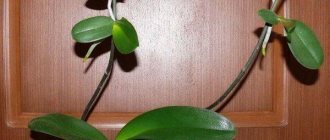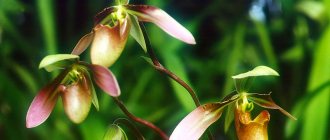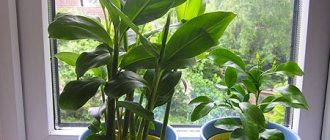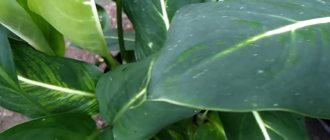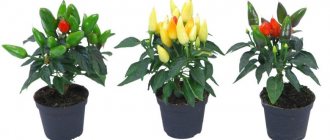The indoor orchid paphiopedilum or lady's slipper stands apart from other plants of the Orchid family. Firstly, most cultivars develop only one flower on a high peduncle, and not several, as in other representatives of Orchidaceae. Secondly, the flower necessarily has a swollen, elongated lip, which is their distinctive feature.
In lady's slippers, orchids from the genus Paphiopedilum , everything is captivating, from compact shoots, the leaves of which are collected in neat, sometimes variegated, double-sided rosettes, to rather large, fancy flowers on pubescent peduncles. Many species grow and bloom well on residential window sills, and some hobbyists collect and keep paphiopedilums exclusively.
After reading this article, you will learn what a lady's slipper flower looks like and how to care for it at home.
Lady's slipper orchid
Description of the flower
This culture is found in the European part of Russia, in the south of Siberia and in the Crimea. Also common in Japan, Mongolia, northern China and Europe.
The rhizome of the variety is thick, but short; on the main root there are many small root shoots. The maximum length of the stem is 60 cm, but most often it does not exceed 35 cm. Leaves grow in numbers of 2-10 pieces. The leaf blades are wide with narrowed ends, yellow-green in color. The edges of the foliage are even and smooth.
Attention is attracted not only by the original shape of the flower, but also by its pleasant subtle aroma. The color of the petals is lemon or bright yellow, the perianth is red-brown.
Peak flowering occurs in mid-summer. Flowers are pollinated by bees, insects and hoverflies. The flower has 3 sepals and 3 petals. The strange shape of the buds helps spiders set traps for their chosen victims.
Distinctive features of Paphiopedilum
The diameter of the flower ranges from 5-20 cm. Nature has endowed the Lady's Slipper with bright, memorable colors, in which you can find shades of green, yellow, red and white. There are also dark inclusions on the petals of this variety. Flowering lasts about 4 months.
The buds of some varieties are covered with wax or light fluff. And in other types of paphiopedilum, the flowers are round, wavy, and the petals may differ in length.
Description of the plant
They are terrestrial or semi-epiphytic plants with an extremely short stem and a rosette of double-rowed linear or oblong leathery leaves . The upper sepals are larger than the rest, the two lateral ones grow together into one small one, directed downwards. The petals descend horizontally or obliquely. The lips are large, bag-shaped, with two vaguely defined upward-pointing lateral petals. Column with a flattened steminode, the shape of which is often a diagnostic feature of the species.
Popular varieties for indoor growing with photos
Gratrixianum
The most common species among amateur gardeners. It is considered a rather whimsical variety, but when optimal conditions are created and regular care is provided, it grows actively and produces buds profusely during the flowering period. A decrease in temperature is easily tolerated.
The front side of the petals is glossy, and the back has a light fluff. The side petals and lips are shiny, waxy in texture and honey-colored.
Malaysian Gold, Rothschild or Kinabalu Gold
In nature, it blooms only after 15 years of development. The leaf blades are rich green, fleshy and glossy. Up to 6 buds are formed on the peduncle (its length is 0.5 m). The average flower size is 15 cm, but there are specimens whose flower diameter reaches 35 cm.
Vietnamese
Tubers of this variety are easy to find in Vietnamese markets. The diameter of the flower is 10 cm, the shade of the petals is coffee or lilac, the lip is always a contrasting color.
Apricot
The flowers are deep yellow, almost orange inside. White species are rare. The leaves are bright, eye-catching, their length is 15 cm.
Snow-white
A miniature variety, reaching only 26 cm in height. With active growth, it forms several leaf rosettes at once, from which leaf plates 15 cm in length grow.
The foliage is bright green above and covered with burgundy spots below. Usually no more than 2 snow-white flowers are formed on the peduncle, in the center of which there is light crimson pollen. Flower growers say that caring for this species is moderately difficult.
Lawrence
Up to 6 leaves grow in one rosette (their width is up to 7 cm and their length is no more than 20 cm). The peduncles grow up to 30 cm in length, are burgundy in color, slightly pubescent, and only one flower grows on them. The maximum diameter of the flower is 13 cm. The sail is white and pink striped, triangular in shape.
Appleton
It grows naturally in Vietnam, Thailand and China. The best place for them is the shade of large trees. The average flower diameter is 10 cm. The petals are lilac-green, the buds bloom in the spring.
How an orchid grows in natural conditions photo: features of growth
Black Jack
The color of the petals is monochromatic, but very bright. The structure of the petals is waxy, glossy, the diameter of one flower is 8 cm. The sail is round in shape with a pointed tip. The side petals have wavy edges. The leaves are small - up to 15 cm in length, dark green, their upper part is covered with a marble pattern.
Delophyllum
Miniature hybrid variety. The leaf blades are oval-shaped, small. The leaf pattern is marbled, but blurred. The peduncle is pubescent, short, no more than 2 flowers bloom on it. The shade of the sails varies from cream to pale olive. The plant is easy to care for.
Which one is better for a beginner?
It is better for beginners to give preference to paphiopedilum species. There are a lot of hybrid varieties, but breeders provide little information about proper care. It is recommended to get acquainted with the culture with the Gratrixianum and Bellatum varieties.
Reproduction methods
This variety of orchid can only be propagated by dividing the bush. When many vigorous rosettes appear, you can begin dividing. If there are at least 3 rosettes in the pot, the plant can already be propagated.
There are several ways to propagate orchids.
Place the separated orchids in the shade and continue to mist them regularly with the potting mix until you see active shoot growth. Then the usual care for perennials is carried out.
Paphiopedilum care at home
Placement in the house, lighting and temperature conditions
It is best to place the culture on the eastern sides of the room. Ideal for the Venus's slipper is diffused lighting. If you place the crop on the south side, you will have to protect it from direct sunlight (using white paper or reflective foil).
For orchids with green leaves, the optimal temperature is +15-+25 degrees. Moreover, in summer the air should be colder than in winter. And for varieties with variegated leaves, it is recommended to maintain the temperature at +20-+30 degrees.
Watering and ambient humidity
The soil should be constantly moist, but waterlogging should not be allowed. Experienced gardeners recommend inserting a stick into the soil as a moisture indicator.
It is better to water in the morning so that excess moisture is absorbed by the evening. It is better to take boiled or filtered water.
Important! Air humidity is maintained at 40%.
Transfer
It is carried out every 2-3 years. When replanting, the root system is inspected, all damaged roots are removed, and the cut sites are sprinkled with crushed coal. The diameter of the pot is chosen to be several centimeters larger than the previous one.
Substrate and pot
The ideal soil for Lady's slipper consists of bark, to which perlite, peat, sphagnum moss and coal are added. You can also add dolomite flour or limestones to the mixture to increase the calcium content.
It is best to choose a plastic pot: it better regulates the level of humidity, and the roots do not grow into the surface of the pot. The size of the container should be 2-3 cm larger than the volume of the root system.
Peculiarities
Only two species are epiphytes :
- Paphiopedilum parishii;
- Paphiopedilum lowii.
Paphiopedilum lowii
Three species of hemi-epiphytes (found growing on the ground and on trees):
- Paphiopedilum hirsutissimum;
- Paphiopedilum villosum;
- Paphiopedilum glanduliferum.
Paphiopedilum hirsutissimum
The remaining species are either terrestrial or lithophytes .
Paphiopedilum flowering
Ways to stimulate flowering
To stimulate the crop to flower, it is recommended to stress it. To do this, stop watering and all air humidification for a while (up to 10 days) or reduce the air temperature by 20-30%. You can also place a flowerpot with a flower in a darker place.
Care during flowering
During the flowering period of paphiopedilum, fertilizing is stopped and the abundance and frequency of watering is slightly reduced. Otherwise, there is no need to change your care regimen.
Paphiopedilum after flowering
After the last bud has faded, you need to wait for the peduncle to dry, and then cut it off, leaving only a couple of centimeters from the root.
origin of name
The name of the genus is formed on the basis of two words: from the name of the homeland of the goddess Venus from the city of Paphos in Cyprus and the word pedilon (shoe, sandal).
Literally Paphiopedilum translates as Paphos slipper or slipper of Paphos .
Ancient mythology tells that once while hunting, the goddess Venus and Adonis were suddenly caught in a thunderstorm. The loving couple took refuge in a cave, and Venus left her wet shoes at the entrance.
A random traveler passing by did not notice the goddess and her lover, but saw golden shoes on the ground. As soon as he bent down to pick them up, the latter turned into beautiful flowers.
Diseases and pests
Low air or water temperatures and improper watering regimes lead to the following diseases:
- anthracnose;
- rhizoctonia;
- late blight
If such a situation arises, the soil must be changed and the plant treated with a fungicide.
The main pests of the Lady's slipper:
- spider mite - the plant is washed under a hot shower, the soil is changed and sprayed with Fitoverm;
- mealybugs and scale insects - the leaf plates are wiped with a soapy solution and the insects are removed mechanically.
The Lady's slipper orchid is not easy to care for. But at the same time it looks very original, attracting the views of others.
How to revive a perennial without roots?
If your Paphiopedilum orchid has almost no roots left, try to restore them as soon as possible. A slight drying of the soil stimulates the formation of roots, which is noted by many gardeners trying to regenerate orchids.
Daily spraying of the soil surface and the bark fraction on the soil will bring results. To regenerate an orchid, you do not need to create special conditions; it is not necessary to place it in a greenhouse. All these measures will give good results after 2 months, when the young roots get stronger.
Every third watering, feed the diseased plant with orchid fertilizer. Rainbow is suitable for this purpose. Water more frequently during hot months.

